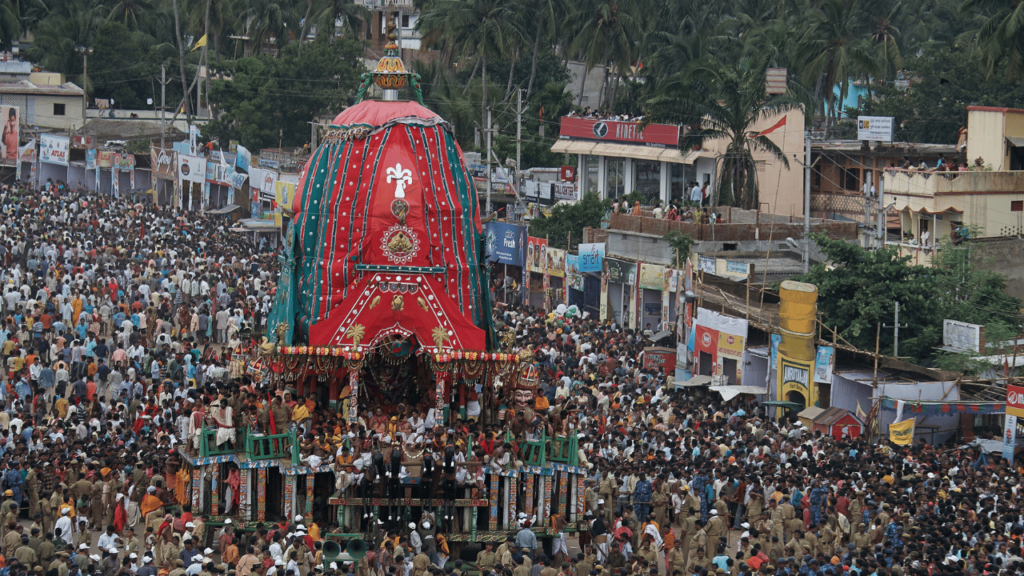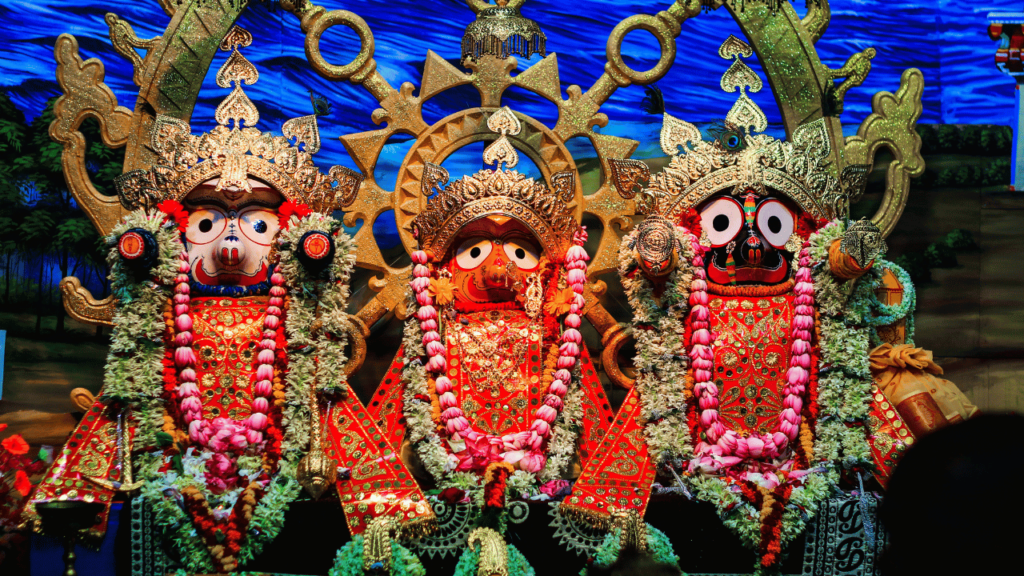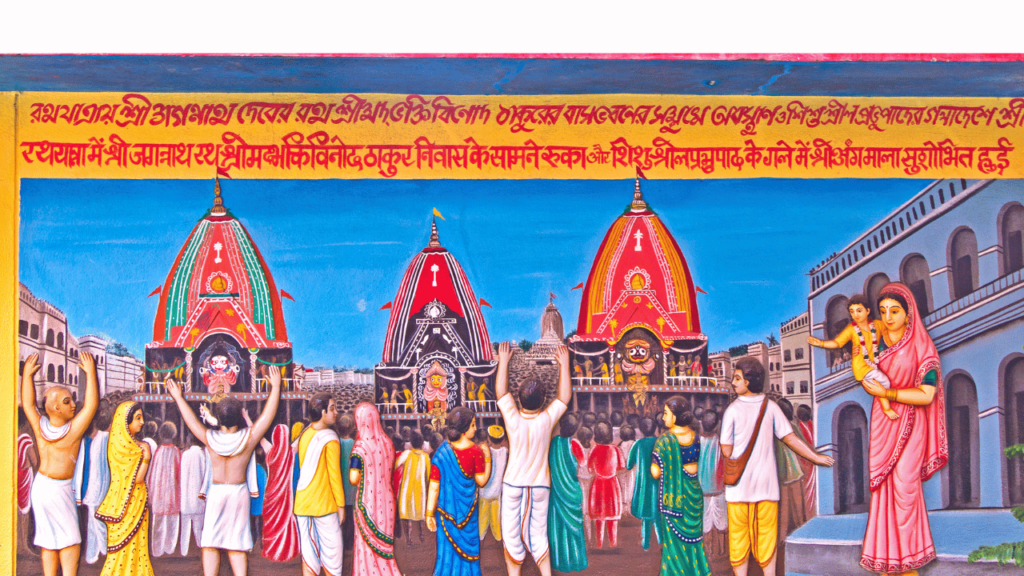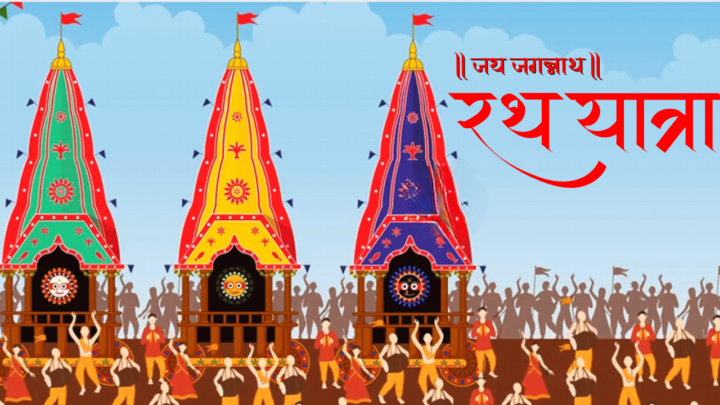History, Celebrations, and Spiritual Wisdom for Modern Seekers
By Dr. Neeti Kaushik
Every year, as the summer sun gives way to the sacred month of Ashadha, the streets of Puri, Odisha, transform into a vibrant ocean of devotion. Amidst rhythmic chants of “Jai Jagannath!”, conch shells, and drumbeats, millions of devotees gather to witness the majestic procession of Lord Jagannath, His elder brother Balabhadra, and His sister Subhadra. This divine event is called Rath Yatra—a celebration not just of gods on wheels, but of the unstoppable journey of faith, humility, unity, and transformation.
As a spiritual guide and seeker, myself, I, Dr. Neeti Kaushik, invite you to explore the sacred meaning of Rath Yatra, how it began, how it is celebrated, and how even those far from Puri can receive divine blessings.
What Is Rath Yatra?

Rath Yatra, meaning “Chariot Journey,” is one of the grandest and oldest religious festivals in the world. It is the only time in the Hindu calendar when deities leave their temples to go out and meet devotees—signifying that the Divine comes down from the altar and walks with us in the crowd.
Held annually in Puri (Odisha), this sacred festival marks the ceremonial procession of Lord Jagannath (a form of Shri Krishna), Lord Balabhadra (Balarama), and Goddess Subhadra from the Jagannath Temple to the Gundicha about 3 km away. The deities travel in enormous wooden chariots pulled by thousands of devotees. After staying there for nine days, they return in a grand event called Bahuda Yatra.
But to truly understand the glory of Rath Yatra, we must go back in time…
How Did Rath Yatra Begin? | The Sacred Origins
The origin of Rath Yatra is steeped in a mix of ancient mythology, historical devotion, and deep symbolic meaning.
🕉️ Mythological Roots:
According to Hindu tradition, this festival commemorates Lord Jagannath’s symbolic journey from the heavens to the earthly realm. He steps out of His temple to meet His devotees, especially those who are unable to come to Him.
The Story of Queen Gundicha
It tells us about Queen Gundicha, the wife of King Indradyumna, the ruler who built the grand Jagannath Temple.
According to this Odia legend, Queen Gundicha was deeply compassionate and troubled by the fact that sinners, the poor, and so-called untouchables were not allowed inside the temple to worship the Lord. She lovingly requested the king to organize a special festival during which Lord Jagannath would leave the temple and travel through the streets, allowing everyone to have His darshan—regardless of caste or status.
It was this heartfelt request that is said to have initiated the tradition of Rath Yatra, turning it into a festival of inclusion, equality, and spiritual liberation.
The Divine Memory of Vrindavan
There’s another tender and deeply moving story from the Skanda Purana and oral Vaishnava traditions that reveals why the deities of Jagannath, Balabhadra, and Subhadra appear in their unique wooden forms—without fully defined limbs—and why their journey touches something timeless in the hearts of devotees.
According to this legend:
One quiet day in Dwarka, Lord Krishna’s queens were seated beside Him. They asked Him to share tales from His childhood in Vrindavan—about the mischievous butter thief, the flute player, the beloved of Gopis. As Krishna spoke of Radha, the cowherd boys, and the forests of Vrindavan, He was suddenly overcome with deep emotion and spiritual ecstasy.
So powerful was His longing and nostalgia that Krishna fainted—lost in the trance of divine memory.
Hearing the commotion, His elder brother Balabhadra (Balarama) and sister Subhadra rushed to the scene. They stood on either side of Krishna, watching over Him with great love and concern. Just then, Narad Muni appeared and witnessed all three siblings in this rare, spiritually elevated state.
In that moment, Narad requested the celestial architect Vishwakarma to immortalize this divine scene by carving wooden deities of the three in exactly the form he saw—a form filled with transcendental emotion, without fully formed arms or legs, but radiating infinite bliss.
Thus were born the now-iconic forms of:
- Jagannath – with wide round eyes, joyful face, and arms melting into His being
- Balabhadra – strong, composed, representing protection
- Subhadra – in the center, calm and serene, embodying divine balance
This legend also ties into the symbolism of the Rath Yatra, which is believed to recreate Krishna’s emotional journey from Dwarka back to Vrindavan—a return to His original devotees, His childhood innocence, and the purest form of love.
In this sense, Rath Yatra becomes not just a physical journey of the Lord but also an emotional pilgrimage of the heart—an invitation to all of us to return to the divine simplicity of love, surrender, and childhood faith.
Historical Roots:
Rath Yatra is believed to have been celebrated for more than 2,000 years, mentioned even in ancient texts like the Skanda Purana and Padma Purana . The present-day Jagannath Temple was built in the 12th century by King Anantavarman Chodaganga, and the tradition of Rath Yatra has been uninterrupted since then.
This makes it not only one of the oldest processions in India, but also a spiritual and architectural marvel that withstood the test of time, foreign invasions, and even natural calamities.
How Is Rath Yatra Celebrated in Puri?
The festival begins in the Hindu month of Ashadha Shukla Dwitiya (second day of the bright fortnight (Shukla Paksha) of Ashadha, usually June–July). Here’s how this divine event unfolds:
1️⃣ Snana Purnima (Holy Bathing Ceremony)
The deities are bathed with 108 pitchers of sacred water. After this, they fall ‘ill’ and rest in isolation for 15 days—a period called Anavasara. This humanizes the gods and makes them more relatable to devotees.
2️⃣ Carving of New Chariots Every Year
Each year, three new chariots are constructed by traditional artisans by using seasoned and sturdy logs of wood, predominantly from specified trees like phassi (cashew) and dhausa (suar). This tradition emphasizes renewal, purity, and devotion.
- Nandighosh (Jagannath’s Chariot) – 45 ft high, 16 wheels, red-yellow canopy
- Taladhwaja (Balabhadra’s Chariot) – 44 ft high, 14 wheels, red-green canopy
- Darpadalana (Subhadra’s Chariot) – 43 ft high, 12 wheels, red-black canopy
3️⃣ Pahandi Bije – Procession to Chariots
The deities are carried out of the temple in a rhythmic, swaying procession amid chants and music. It symbolizes the Lord joyfully stepping out to meet His people.
4️⃣ Chhera Panhara – The King Becomes a Servant
In a deeply humbling ritual, the Gajapati King of Puri sweeps the chariot floors with a golden broom, reminding us that before God, everyone—king or commoner—is equal.
5️⃣ Pulling the Chariots – A Journey of Liberation
Devotees eagerly pull the massive chariots using thick ropes. It is believed that those who even touch the rope are blessed with the cleansing of karma and the opening of spiritual paths.
The deities stay at Gundicha Temple for nine days, after which they return to the main temple in a similar grand procession called Bahuda Yatra.
What Does Rath Yatra Teach Us?

Rath Yatra is more than an event—it is a deep spiritual metaphor. Here’s what it represents:
- God Comes Out for Us: The Divine is not limited to temples; He comes to meet us wherever we are—in joy, in sorrow, in chaos.
- The Wheel of Life: The chariot’s wheel symbolizes karma and the cyclic nature of life. We must learn to navigate it with wisdom.
- Equality in Devotion: From kings to commoners, everyone pulls the rope together. In the eyes of God, all are equal.
- Letting Go of Ego: The Lord leaving His sanctum to travel the dusty road teaches us humility.
- Life Is a Journey: And just like the Rath Yatra, we must keep moving—towards love, truth, and divine connection.
What If You Can’t Visit Puri? Simple Ways to Celebrate from Home

Not everyone can travel to Odisha—but divine blessings know no boundaries. Here’s how you can participate in the Rath Yatra from wherever you are:
- Set Up a Small Altar
Place a photo or idol of Lord Jagannath, Balabhadra, and Subhadra. Decorate with flowers, yellow cloth, and incense.
2. Chant the Name of the Lord
Chant the Mahamantra:
“Hare Krishna Hare Krishna, Krishna Krishna Hare Hare
Hare Rama Hare Rama, Rama Rama Hare Hare”
Even a few minutes of mindful chanting can bring immense peace.
3. Offer Bhog
Make simple sattvic food like kheer, fruits, or chhena sweets and offer them to the Lord with love.
4. Write a Devotion Journal
Write a heartfelt letter to Lord Jagannath—express your feelings, questions, pain, or gratitude. Offer it on your home altar.
5. Visualize the Journey in Meditation
Close your eyes and imagine the chariot, the crowd, the chanting, the Lord smiling at you. Let the visualization cleanse your inner landscape.
Final Words from Dr. Neeti Kaushik
In a world where we often get caught in deadlines, comparisons, and material goals, Rath Yatra reminds us of a higher path—the journey of the soul back to its source. It reminds us that we are not alone; there is a divine charioteer guiding us, waiting for us to surrender the rope.
You may not be in Puri.
You may not physically touch the chariot.
But if your heart calls out, even once—“Jai Jagannath!” with true devotion,
He will come rolling into your life—bringing grace, clarity, healing, and love.
So this Rath Yatra 2025, let’s not just watch a festival…
Let’s live it.
Let the Lord ride His chariot across your doubts, through your fears, and straight into your heart.
✨ Wishing you a blessed and soul-stirring Rath Yatra!
With love and light,
Dr. Neeti Kaushik
For more information, visit our YouTube Channel: “Nitty Gritty With Dr Neeti Kaushik”



Prachi Manchandani
After reading and understanding this article aapne Jagannath temple pahuncha diya,”JAI JAGANNATH”
Mousumi Dutta
Thank you so much ma’am for this beautiful divine piece of wisdom 🙏. Jai Jagannath Mahaprabhu, Jai Balabhadra Mahaprabhu, Jai Subhadra Maa 🙏♥️🕉🌻🌼🌸💐🌹. I love you Jagannath Mahaprahu🙏. Thank you so much for everything 🙏♥️😘😀🤗
Manda Panchal
Jay jagannath. Thank you for giving knowledge of lord jagganath.
Madhuri Naidu
Simply amazing Mam😊felt so blessed after reading this. My mind reached there. Superbly explained the importance of Rath Yatra. feeling emotional. Jai Jagannath 🙏🙏
Unanimous
Thank you very much from bottom of my heart’s.